Gloster Gladiator Mk.II
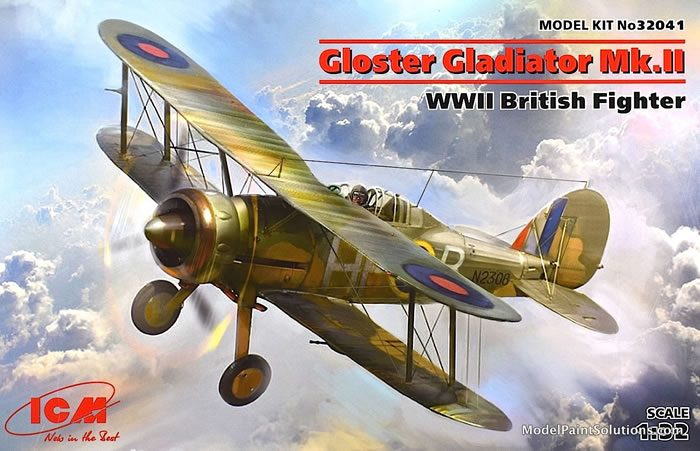
ICM, 1/32 scale
S
u m m a r y : |
Description and Item No.: |
ICM Kit No. 32041 - Gloster Gladiator Mk.II |
Contents and Media: |
116 parts in medium grey plastic; nine parts in clear plastic; one decal sheet covering four subjects |
Price: |
£43.99 EU Price (£36.66 Export Price) plus shipping available online from Hannants |
Scale: |
1/32 |
Review Type: |
First Look |
Advantages: |
Nicely molded surface details, a detailed cockpit and engine, nicely done fabric effects, conventional engineering, and a relatively low parts count suggests this will be a straightforward build. |
Disadvantages: |
No seat harness supplied. |
Recommendation: |
It is great to see ICM delivering this icon in the increasingly popular scale of 1/32. Detail is good, parts breakdown looks pretty straightforward and the model looks great in the box. Now the only remaining question is, how does it build?. |
Reviewed by John Miller
The Gloster Gladiator was a British-built biplane fighter that was used by the Royal Air Force (RAF) and the Fleet Air Arm (FAA) (as the Sea Gladiator) and was exported to a number of other air forces during the late 1930s.
Developed privately as the Gloster SS.37, it was the RAF's last biplane fighter aircraft and was rendered obsolete by newer monoplane designs even as it was being introduced. Though often pitted against more formidable foes during the early days of the Second World War, it acquitted itself reasonably well in combat.

The Gladiator saw action in almost all theatres during the Second World War, with a large number of air forces, some of them on the Axis side. The RAF used it in France, Norway, Greece, the defence of Malta, the Middle East, and the brief Anglo-Iraqi War (during which the Royal Iraqi Air Force was similarly equipped). Other countries deploying the Gladiator included China against Japan, beginning in 1938; Finland (along with Swedish volunteers) against the Soviet Union in the Winter War and the Continuation War; Sweden as a neutral non-combatant (although Swedish volunteers fought for Finland against USSR as stated above); and Norway, Belgium, and Greece resisting Axis invasion of their respective lands.
The South African pilot Marmaduke "Pat" Pattle was the top Gladiator ace with 15 victories with the type.
The Finnish Air Force was the last to use the Gloster biplane in combat. It was under Finnish insignia that the Gladiator achieved its last air victory. During the Continuation War, against the Soviets, Glosters supported the advance of the Karelian Army around Lake Ladoga. On 15 February 1943, 1st Lt Håkan Strömberg of LLv 16, during a reconnaissance mission along the Murmansk railway, between the White Sea and the Lake Onega, spotted, on Karkijarvi, a Soviet Polikarpov R-5 taking off. Stromberg dived on it and shot it down into the forest near its airfield with two bursts. This was the last confirmed victory by the Gladiator.
General Characteristics
- Crew: 1
- Length: 27 ft 5 in (8.36 m)
- Wingspan: 32 ft 3 in (9.83 m)
- Height: 11 ft 9 in (3.58 m)
- Wing area: 323 sq ft (30.0 m2)
- Airfoil: RAF 28
- Empty weight: 3,217 lb (1,459 kg)
- Gross weight: 4,594 lb (2,084 kg)
- Powerplant: 1 × Bristol Mercury IX 9-cylinder air-cooled radial piston engine, 830 hp (620 kW)
- Propellers: 3-bladed fixed-pitch metal propeller
Performance
- Maximum speed: 253 mph (407 km/h, 220 kn) at 14,500 ft (4,420 m)
- Cruise speed: 210 mph (340 km/h, 180 kn)
- Stall speed: 53 mph (85 km/h, 46 kn)
- Endurance: 2 hours
- Service ceiling: 32,800 ft (10,000 m)
- Rate of climb: 2,300 ft/min (12 m/s)
- Time to altitude: 10,000 ft (3,048 m) in 4 minutes 45 seconds
Armament
-
Guns:
-
Initially; Two synchronised .303 in Vickers machine guns in fuselage sides, two .303 in Lewis machine guns; one beneath each lower wing.
-
Later aircraft; Four .303 calibre M1919 Browning machine guns; two synchronised guns in fuselage sides and one beneath each lower wing.
-
In at least some Sea Gladiators, provision existed for a pair of Brownings to be fitted under the upper wings as well, bringing the total to six. Official service release trials were not completed before the Sea Gladiators were replaced by later types – but some upper wing Brownings may have been fitted in the field, in particular in Malta.
* Historical text adapted from Wikipedia
Introduction
Once again my Saturday started with a good cup of coffee, Skyway Hobby Shop, good friends, and a 1/32 Gloster Gladiator. That last part was courtesy of the evil owner of Skyway who seems to know my aviation weaknesses better than I do. Being a fan of ICM kits, I had high hopes for this Gladiator; I’m not let down. This is a very nice model that will look very convincing when assembled. Well done, ICM.
I used to begin reviews of ICM kits with the “being a limited production kit” riff. The finesse and fidelity of the surface details on this kit really aren’t best described as “limited production” however. This kit is nicely molded with scale appropriate surface details and little-to-no flash. Parts layout and engineering are conventional suggesting this will be a straightforward build.
As usual, assembly begins with the cockpit, wherein the exposed tubular frame surrounding the seat, as well as the floorboard, are nicely rendered. The main panel is nicely molded and the instruments dials are supplied as decals. Unfortunately, no seat harness is provided. The kit provides adequate detail right out of the box but super-detailers will see this cockpit as an invitation to apply their skills.
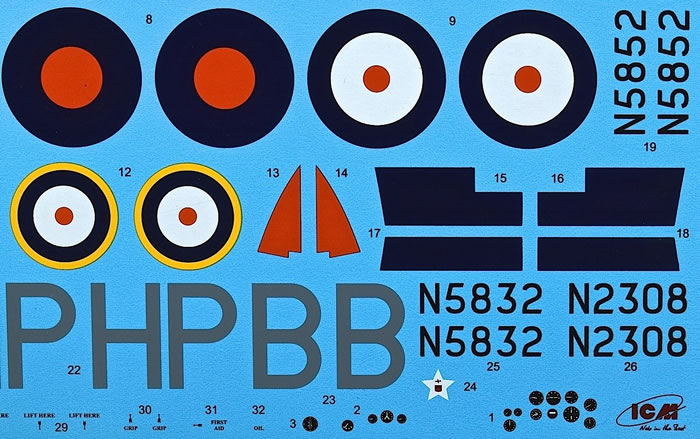
With the completed cockpit and tail wheel assembly captured between the fuselage halves, the gun sight, along with its nicely molded tubular support frame, is added and this really increases the level of detail in the cockpit area. The control surfaces are next in sequence with halved rudder and horizontal stabilizer/elevator assemblies.
The canopy parts are crisply molded with scale appropriate framing and crystal-clear panels. Of note is the inclusion of two different rear canopies. Both of the schemes covered by this boxing require the framed version (part E7).
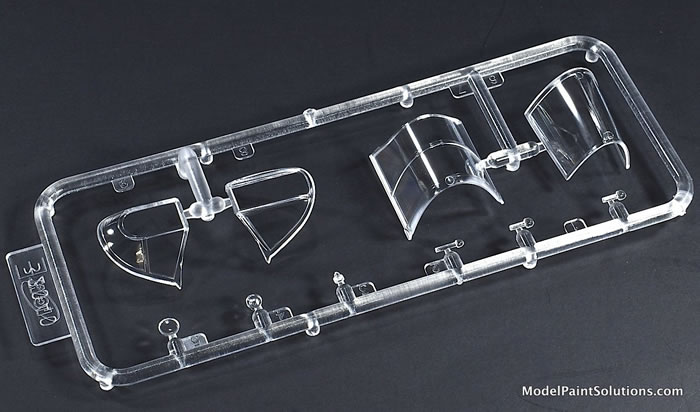
The bottom wing is comprised of a full-span lower half with left and right upper halves.
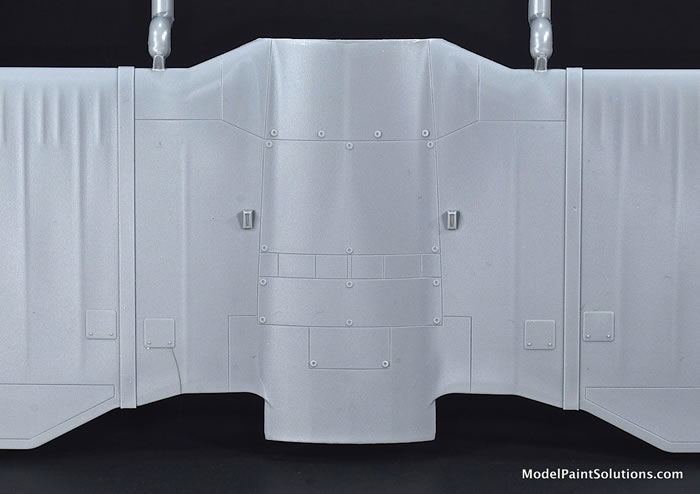
The single-piece lower ailerons are poseable. The upper wing is comprised of full-span upper and lower halves with poseable, one-piece, ailerons. The interplane and cabane struts are all single pieces.
The nicely molded Bristol Mercury 9-cylinder radial is next in sequence and, like the cockpit, super-detailers will go nuts with what can be done with what’s provided right out of the box. The engine will look very convincing when built.
The single-piece interplane and cabane struts fit into what appear to be very sturdy attach points in the upper and lower wings. Multiple diagrams are provided to assist the builder with rigging: nice.
The front windscreen and rear, siding canopy are crystal clear and crisply molded with scale-appropriate faming.
Markings
The decals, by ICM, are well printed with good registration and color density.
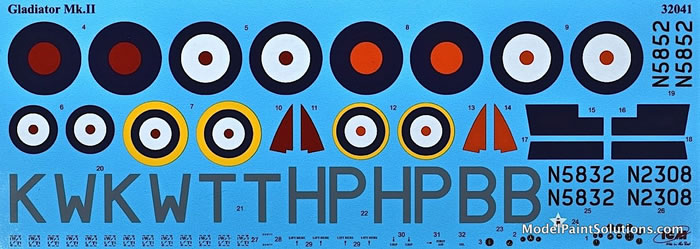
Airframe stencil data and markings for four airframes are provided as follows:
-
Gloster Gladiator Mk.II, No. 247 Squadron, Roborough, August 1940.
-
Gloster Gladiator Mk.II, Pilot Flt. Lt. M.T. St.J. Pattle, No. 80 Squadron, RAF, Greece, December 1940.
-
Gloster Gladiator Mk.II, No. 1 Squadron, SAAF, East Africa 1940.
-
Gloster Gladiator Mk.II, No. 615 (County of Surrey) Squadron, RAF, St. Inglevert (Northern France) April 1940.
With the exception of a seat harness, this kit provides sufficient detail right from the box. The surface details are crisply rendered and the simple engineering suggests this will be a pretty easy build. And the result, a big scale Gloster Gladiator, is seldom seen on the model show tables. Recommended!
Thanks for reading along,
Review kit provided by my retirement fund, again.
For more on this review visit Modelpaintsolutions.com
Text and images copyright © 2020 by Model Paint Solutions
Review Text and Images Copyright © 2020 by John Miller
Page Created 25 June, 2020
Last updated
25 June, 2020
Back to HyperScale Main Page
Back to Reviews Page

|
Home
| What's New |
Features |
Gallery |
Reviews |
Reference |
Forum |
Search